Green Zone Fortunes is an investment research service run by Adam O’Dell of Money & Markets. And according to the company site, it “provides you with the knowledge and tools you need to gain financial freedom.”
But can O’Dell’s service really help you become financially free?
Or is the whole thing one big overhyped scam?
That’s what I wanted to know.
So I decided to join the service and share what I found in this review.
Ahead, I’ll show you what Green Zone Fortunes is all about, what you get if you join, and how the model portfolio has performed since the service began in 2019.
What Is Green Zone Fortunes?
Green Zone Fortunes is a “multifaceted investment research service” that provides subscribers with a monthly newsletter and several other resources, including a model portfolio and weekly “hotlist” of stock ideas.
At the core of the service is the “Green Zone Ratings” system, which the Money & Markets website describes as a “proprietary six-factor rating system” O’Dell developed.
I’ll go into more detail on how this works shortly, but the gist is that this rating system, along with other factors, is what determines the stocks that Adam O’Dell recommends.
In short, O’Dell starts by looking for different “mega trends,” finds companies that his Green Zone Ratings system is “bullish” on, and then looks for so-called “underappreciated” “X-factors” that he says “most quantitative models and discretionary strategists miss.”
Is this a winning strategy?
As I’ll explain shortly, some of O’Dell’s picks have done really well, so I guess he must be doing something right. But not everything he’s recommended has worked out, either.
In fact, the model portfolio contains quite a few losing stocks as of writing this (November 16, 2022), which shows you that no stock selection “system” is perfect.
In any case, Green Zone Fortunes costs $47 per year, and the main thing you get access to as a subscriber is the monthly newsletter, model portfolio, and weekly hotlist.
- The newsletter breaks down a so-called “mega trend” that Adam O’Dell is tracking and highlights a company he thinks can benefit from it (and why).
- The model portfolio is where you can find all of O’Dell’s stock picks and any related info, such as what price he recommended it at, when, suggested stop-loss, and more.
- And the weekly hotlist is a list of ten “high-momentum stocks” that his rating system is “bullish” on.
There’s more to the service than that, such as research reports on specific companies he’s interested in, video training, and trade alerts, but those are the main aspects.
Next, I’ll give you some insight into the guy behind all of this, Adam O’Dell, and then I’ll show you what the member’s area looks like and discuss how his picks are working out.
Who Is Adam O’Dell?
The Money & Markets website makes some pretty bold claims about Adam O’Dell’s success. It literally refers to him as one of the “best investment analysts in the world” and says he has “beaten the returns” of George Soros, Carl Icahn, and Warren Buffett since 2012, which is when he began sharing his trade recommendations online.
“Adam O’Dell is among the best investment analysts in the world. A former hedge fund manager, he began publishing his trade recommendations online in 2012. Since then he’s beaten the returns of George Soros, Carl Icahn and even Warren Buffett.”
Source: https://moneyandmarkets.com/expert/adam-odell
The site also states that he’s a “former hedge fund manager,” and based on some of his stock teaser presentations I’ve encountered, he’s a Chartered Market Technician (CMT).
Is any of that true?
I would take the stuff about him beating the returns of Soros, Buffet, and Icahn with a grain of salt, as that’s a very bold claim and one that’s virtually impossible to verify, especially since O’Dell has run many different services over the years.
But setting that aside, here’s what I learned about his career:
- According to the most recent newsletter (October 2022), O’Dell started his career as a student at the West Virginia University School of Medicine but realized that his “passion for learning the financial markets was greater” than his passion for medicine.
- From there, it appears as though he earned an MBA from the University of Phoenix and had various roles in finance before getting into the newsletter business. According to his LinkedIn profile, he’s worked as a financial planner, forex trader, and account executive at various firms.
- It’s unclear when, but somewhere along the way, he became a CMT, which is basically someone who’s an expert in trading and technical analysis. Furthermore, according to cmtassociation.org, O’Dell has a “diverse background in financial planning, proprietary trading, quantitative research and systems development.”
- Before starting Money & Markets, O’Dell was part of a financial publishing company called Charles Street Research, which doesn’t appear to be operating anymore. And he was also a big part of Dent Research, which was acquired by Agora, a multinational corporation that owns many individual publishers, around ten years ago.
- It’s unclear who owns Money & Markets, but O’Dell appears to have first contributed to the site in late 2019 and, according to his LinkedIn profile, became the “Chief Investment Strategist” of Money & Markets in early 2020.
- Today, O’Dell runs four services (that I know of). His flagship service is Green Zone Fortunes (formerly called Green Zone Stocks), but he also runs three higher-priced services: 10X Fortunes, Wednesday Windfalls, and Max Profit Alert.
Does he have a good track record?
I’ll show you how his Green Zone Fortunes picks have performed shortly, but as for his overall results as a stock picker, it’s hard to verify that properly.
What I can say, however, is that his “Cycle 9 Alert” service appears to have been his longest-running flagship service over at Dent Research, and the ratings and comments on Stock Gumshoe about this service make me question its overall success.
He also appears to have run a service called the Rich Investors Club and Cannabis Paydays, neither of which appear to be still in operation.
As for his Money & Markets services, these are all relatively new, so there are not a lot of reviews out there yet, which makes it hard to know how worthwhile they are.
Although there are some reviews on TrustPilot about Money & Markets itself, the Florida-based company behind all of this, which are mostly positive as of writing.
Anyway, aside from all of that, through my research, I found that O’Dell has authored several Business Insider articles between 2015 and 2016.
And I’ve looked into numerous stock teaser presentations he’s released.
For instance, I’ve looked into (and shared my guesses on) his “Imperium” stock pick, his “x.AI” stock, and “Infinite Energy” stock, which are all tech companies he’s pitched.
You can see the full archive of O’Dell stock teasers I’ve written about if you want to know more, but the gist is that he releases different presentations aimed at promoting the Green Zone Fortunes service, and I’ve looked into a bunch of them on this site.
In any case, let’s dig deeper into the Green Zone Fortunes service itself so that you have a better idea of what to expect if you decide to give it a try.
Overview of the Green Zone Fortunes Member’s Area
I ended up joining Green Zone Fortunes through O’Dell’s stock teaser presentation about Imperium, which seems to be one of his most popular sales pitches.
Normally when I join newsletters like this, I’m greeted with a bunch of upsells immediately after joining. But surprisingly, that wasn’t the case with this service. Instead, I was greeted with a video prompting me to check my email to access the member’s area.
So that’s what I did.
And eventually, I wound up in the member’s area:

And if you expand the “view more options” tab, you basically get a bunch of different links that take you to different sections of the member’s area:
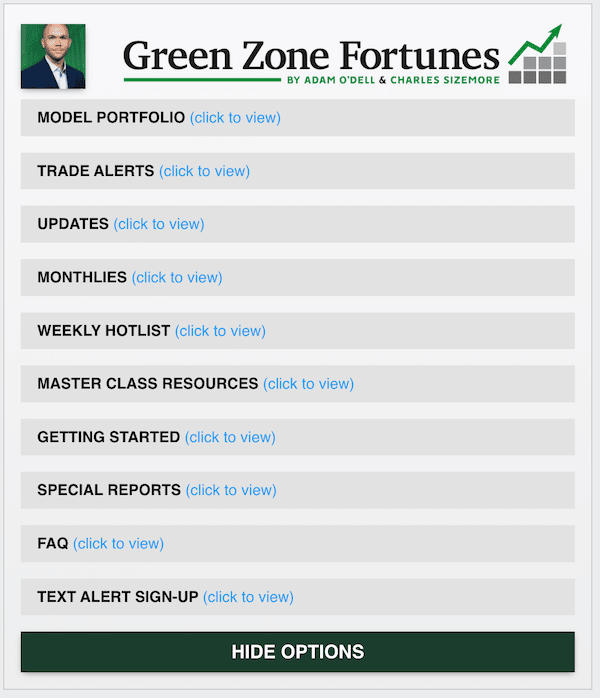
The main sections of the member’s area are the model portfolio (stock picks) and monthlies (monthly newsletters), which I’ll delve into shortly.
But there are several other aspects of the service worth noting:
- The “updates” and “trade alerts” sections basically keep you updated on what’s happening with O’Dell’s recommendations.
- The “weekly hotlist” section gives you a downloadable list of ten stocks and their associated “green zone ratings” each week. From what I understand, these are ten stocks his system has rated the highest each week.
- The “master class resources” page features a five-module video series dubbed “Adam O’Dell’s Momentum Principle Millionaire Video Series.” All up, there’s about an hour’s worth of video training on O’Dell’s investment strategy here, and it’s focused on what he calls his “Momentum Principle” (aka “buy high and sell higher” strategy).
- There’s a “special reports” page where you can access all the research reports O’Dell has put together for subscribers of Green Zone Fortunes, such as the ones he teases in the different presentations he’s released.
- Subscribers can use a stock rating tool known as “Green Zone Ratings,” which allows you to see how O’Dell’s system rates it based on six metrics (more on this shortly).
- There’s an FAQ page that answers some of the most common questions people ask about the service.
- And there’s a page where you can sign up to receive SMS alerts about his picks.
Now with that out of the way, let’s discuss the portfolio…
The Green Zone Fortunes Model Portfolio
All up, there are 78 recommendations in the model portfolio as of writing, and these are spread across three different “sub-portfolios” (for lack of a better word).

- One portfolio is called “Open Positions,” which seems like an odd name to use since all three portfolios are “open” (aka active).
- The second portfolio is called the “Green Zone Income Portfolio,” which is focused on dividend stocks.
- And the third one is called “Special Report Trades,” which seems to be the stocks associated with the reports shown in the “special reports” section I mentioned earlier.
How have his picks performed?
As of writing, the “open” portfolios I just mentioned contain more winners than losers, according to what is shown in the member’s area.
Out of 43 picks, 28 are in the green, while 15 are in the red.
These are all open/active recommendations, though, which means how they’ve performed on a daily basis is still up in the air until O’Dell recommends closing (aka selling) them.
What about the closed recommendations?
As of writing, there are 35 picks in a fourth “Closed Positions” portfolio, and the majority of these are in the red. Only nine out of 35 picks are in the green.
Given how many picks there are, I couldn’t take a screenshot of the whole portfolio in one go. But below, you will see three screenshots of the closed positions, which were last updated on November 15, 2022.
Note that you can click on any image below to see a larger version:
I can’t reveal the names/tickers of those picks since it’s a paid service. But from what I can tell, that’s a full history of all the closed Green Zone Fortunes stock picks.
And as you can see, unlike the open/active recommendations, most of the closed recommendations are down right now.
That’s obviously a bummer.
But to Money & Market’s credit, not many newsletter services in this space even share that information. Instead, most bury their track record in the newsletter archives, which makes it virtually impossible to figure out how their recommendations have worked out overall.
In any case, taking both the open and closed positions into account as of writing, I guess you could sum it up by saying that the overall performance is a mixed bag.
The “Monthlies” (aka Newsletters)
The “monthlies,” as O’Dell refers to them, are the monthly newsletters. And this is where O’Dell shares his latest recommendation and updates each month.
Here’s a preview of a recent issue to show you how it looks:
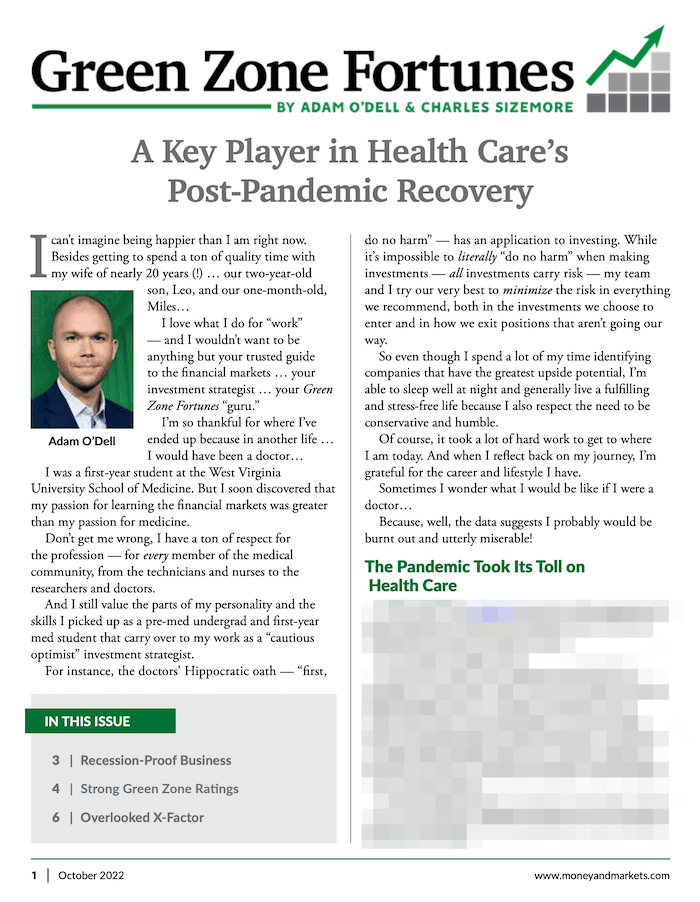
How does it work?
Each month, O’Dell discusses a “mega trend” he’s following, a company that he thinks can benefit from it, and explains how it stacks up against his “green zone ratings.”
He also discusses an “x-factor” that he believes the company has, which is more or less something he thinks could give the company an advantage over the competition.
And finally, O’Dell gives you specific instructions on what he’s recommending. For instance, the ticker, the price he recommends buying up to, and the stop loss he recommends.
Is it worth a read?
This newsletter may not interest folks who are looking for a global macro-style newsletter, but it may interest those who want to take advantage of different trends and who want an in-depth breakdown of individual companies associated with those trends.
It’s not tied to any one sector, either.
O’Dell is probably best known for his tech and biotech-related pitches, but the companies he recommends are spread out across multiple sectors.
This month, for example, he focused on the healthcare space. But in previous monthly newsletters, O’Dell has focused on companies in the natural resources, energy, manufacturing, and real estate space (among others).
Also worth mentioning is that O’Dell isn’t the only one who writes the newsletters; Charles Sizemore is listed as the co-editor and contributes to them as well.
I’m not familiar with Sizemore, but according to his InvestorPlace profile, he’s the “chief investment officer” of Texas-based investment firm Sizemore Capital Management.
He also authored numerous Forbes articles between 2011 to 2017, and his profile states that his work has been featured on numerous well-known media shows/sites.
How Do the “Green Zone Ratings” Work?
There are six factors that contribute to O’Dell’s “Green Zone Ratings” system: Momentum, Value, Quality, Growth, Size, and Volatility.
Here’s a screenshot of a recent newsletter explaining each of these:
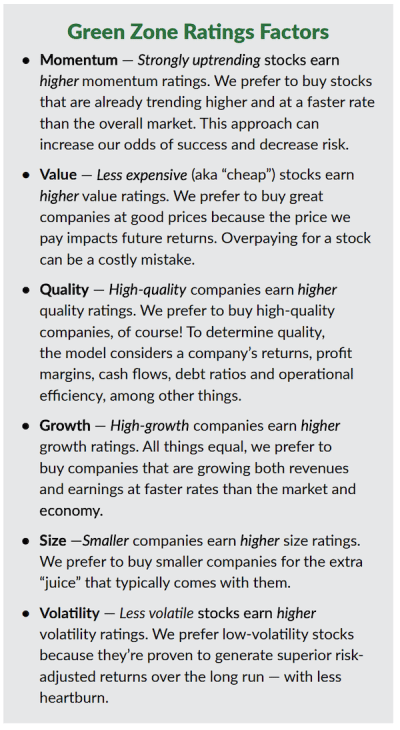
Based on that, the ratings seem to favor “quality,” potentially undervalued growth stocks that are “trending higher and at a faster rate than the overall market.”
The system also seems to favor smaller stocks and those that are less volatile, which seems like a contradiction since small stocks are typically more volatile, but from what I’ve seen, O’Dell doesn’t recommend “tiny” stocks anyway. Some of his picks are smaller, but the smallest ones I’ve looked at have a market cap of around $1 billion or so.
As for the actual ratings, these range from 0 to 100. And here’s how O’Dell explained what these numbers mean in a recent newsletter:
“To that end, we rate every stock under consideration using my six-factor Green Zone Ratings system, which picks a company apart using three fundamental and three technical factors.
“We run this model daily on a universe of more than 8,000 stocks and rank based on ‘Overall Rating.’
“These ratings range from 0 to 100, where 0 is ‘worst,’ and 100 is ‘best.’ Anything over 60 is ‘Bullish,’ meaning we expect it to double the market’s return over the next 12 months.
“And any stock rating over 80 is ‘Strong Bullish,’ meaning we expect it to beat the market by a factor of three over the following 12 months.”
As a subscriber of Green Zone Fortunes, you can also punch in the name or ticker of a stock inside the member’s area to see how the system rates it. And to show you how it looks – here’s an example search I did of a well-known large-cap energy company:
So the rating system isn’t just something O’Dell uses.
As a subscriber of the service, this is a standalone tool you can use to see the “Green Zone Ratings” on different stocks you want to research. And below the “ratings,” there’s a stock chart, company information, and financial data provided by TradingView.
The inclusion of these resources makes Green Zone Fortunes similar to a service I recently reviewed called the Power Gauge Report by Chaikin Analytics.
Although the Power Gauge Report’s “Power Pulse” rating system is based on a lot more metrics and appears to be a more comprehensive tool in comparison.
Is Green Zone Fortunes Legit?
I don’t believe that the Green Zone Fortunes service is a scam because, for $47, you do get your money’s worth. But there are some things that make me hesitant to recommend it, such as the overhyped sales pitches used to promote the service.
This sort of thing is very common in the newsletter industry, and while O’Dell’s presentations don’t strike me as the worst of the bunch, the marketing is very offputting to me.
Another thing you might want to be aware of is that while the service costs $47 to join, it automatically renews for $79 after the first 12 months.
The Money & Markets order page I joined through does disclose this, and it’s very easy to turn the auto-renew function off in the member’s area.
But this higher-priced auto-renew setup isn’t exactly “advertised” either, and I think it could easily catch some by surprise, hence why I thought it was worth mentioning.
In any case, the bottom line is that the service itself isn’t a scam, but I wouldn’t join this (or any service) expecting to get rich overnight or without understanding that it’s entirely possible you could lose money following the recommendations.
Cost and Refund Policy
It seems to depend on where you sign up as to how much the service costs. But right now, the “Imperium” sales pitch leads to a $47 sign-up page.
And while I was on the order page, I somehow managed to trigger a discount offer of $19 for six months after trying to exit the order page.
So you might be able to score a discount that way, too.
Either way, the service automatically renews at $79 after the first 12 months, regardless of what price you pay.
What about the refund policy?
That is somewhat murky… the terms and conditions page on the Money & Markets website states that “the refund and credit policy” can be found on the “order form” and in the “confirmation email,” but I wasn’t able to find that info in those places.
The ONLY page I could find anything about a refund was on the sales pitch I joined through, where O’Dell says that you can “cancel within the first 365 days and receive a full refund of your subscription fee.”
That seems pretty clear, and if the company honors this, that’s a good policy.
However, since this is not explained on the order page or in the confirmation email, as per what the terms page says, I can’t confirm for sure what the deal is.
Not to mention, each promotion is different. So there could be a different refund policy associated with different promotions the company runs and different services they sell, which is why it may be worth checking with them before joining.
Pros and Cons of Green Zone Fortunes
Before I wrap this review up, I thought I’d share a quick breakdown of the main things I like and don’t like about the service, which may help you make a more informed choice.
What I Like:
- As a Green Zone Fortunes subscriber, you get access to 12 months worth of monthly newsletters, video training, a model portfolio, a stock rating system, and weekly stock ideas, which I think is pretty decent for $47.
- O’Dell’s picks are diversified across numerous sectors and countries, and the stocks have varying market caps. So the service may suit those looking for a service that shares stock ideas that aren’t tied to any one sector or location.
- Many services I’ve joined “bury” the performance of the stock picks, but some show you the full history of the “closed” positions, which appears to be the case with Green Zone Fortunes.
What I Don’t Like:
- Services like Green Zone Fortunes are all about mass marketing, which is something I am not a fan of because their tactics often don’t set people up with a realistic idea of what to expect, and the emails can be very annoying at times, among other things.
- Even if the service had an amazing track record, that wouldn’t guarantee you’d make money with it, and there are currently more winning than losing picks in the “open” portfolios. But the recommendations in the “closed portfolio” are not what I would have expected based on some of the sales pitches I’ve seen.
- The Green Zone Fortunes recommendations I’ve seen are all regular stocks, but one of the training modules discusses options trading as a way to “turbocharge your Momentum Principle gains.” And options can be incredibly risky for beginners, which seems to be the people this service caters to.
Bottom Line
Considering what you get with a Green Zone Fortunes subscription, I think the asking price is pretty reasonable. I also like that the service isn’t tied to any one sector or “theme,” and found the research in the newsletters to be quite informative.
But one thing I want to emphasize is that this is not a get-rich-quick thing.
It’s easy for stock-picking “gurus” to cherry-pick their best recommendations and use that as a way to say that you “could have” made lots of money following their picks.
But often, when you look at ALL of the recommendations associated with a given service as a whole, the average results are nowhere near that good. And as a subscriber, it’s not like you know which picks will or won’t work out in advance.
My point? Don’t buy into the hype.
It is absolutely possible that you could lose money following the recommendations you receive as a Green Zone Fortunes subscriber (even if the “green zone rating” system shows that the stock is “100”). And that’s true for any newsletter service.
At the end of the day, only you can decide if Green Zone Fortunes is right for you. But hopefully, what I’ve shared in this review helps make your decision a bit easier.
Thanks for reading.


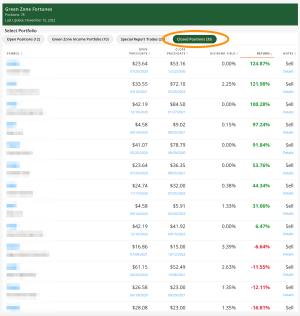
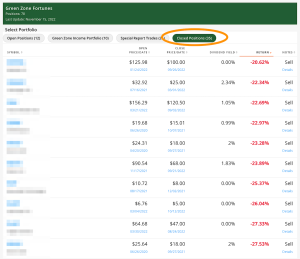
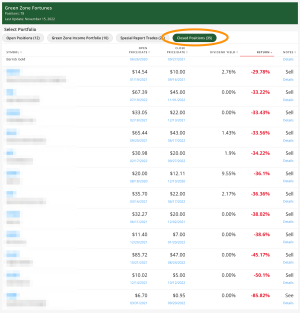





What was the name of the green stock designed to use wasted electricity, and refunnel it back to the consumer?
Thank you.
Excellent post. Thank you so much for taking the time to explain in detail how this subscription works. It’s a completely objective and helpful analysis.
My pleasure, glad you found it helpful and thanks for the comment.